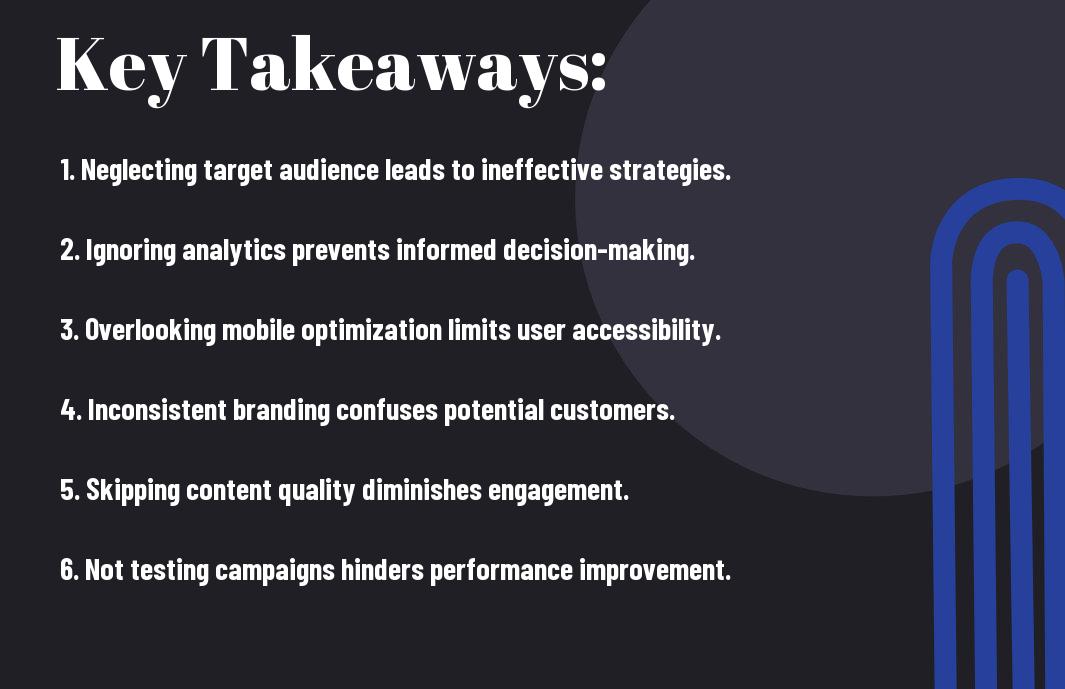Just because you have a digital marketing strategy in place doesn’t mean it’s flawless. In fact, many marketers unknowingly make common mistakes that can hinder their efforts and lead to lost opportunities. By identifying these pitfalls, you can enhance your campaigns, boost your online presence, and ultimately drive better results. This post will guide you through the five mistakes you should steer clear of to maximize your digital marketing success.

Ignoring Target Audience
Table Of Content
The success of your digital marketing efforts largely hinges on your understanding of your target audience. Failing to identify and connect with your audience can lead to wasted resources and missed opportunities. By honing in on specific demographics, interests, and behaviors, you can craft tailored marketing strategies that resonate and engage. Utilize various tools like surveys, social media analytics, and customer feedback to conduct effective audience research and segmentation.
Understanding Your Audience
Before entering into your marketing strategies, make sure to thoroughly understand your audience. Defining your target demographics, interests, and behaviors is important for creating relevant content that speaks directly to them. Utilize methods such as surveys, focus groups, and analytics tools like Google Analytics or Facebook Insights to gather data and segment your audience. By investing time in understanding who your audience truly is, you can significantly enhance your marketing effectiveness.
Personalization versus Generalization
Across the digital marketing landscape, the effectiveness of personalized content cannot be overlooked. A one-size-fits-all approach often leads to poor engagement and conversion rates, as it disregards the unique needs of individual users. By implementing personalization strategies—such as tailored emails, targeted offers, and content that speaks to specific interests—you can significantly improve user engagement and loyalty. (Your personal touch can make all the difference in how your audience perceives your brand.)
Target your campaigns by prioritizing personalization over generalization. You can achieve better results by analyzing user behavior and preferences to create custom messages that resonate with distinct audience segments. Implement data-driven approaches like dynamic content creation, personalized email campaigns, and audience segmentation. This helps foster a deeper connection and encourages higher conversion rates. (Investing in personalization is an important decision that can elevate your marketing efforts.)
Overlooking SEO Best Practices
Any digital marketing strategy is incomplete without a solid understanding of SEO. Failing to implement SEO best practices means you risk being overlooked by potential customers searching for your products or services. Prioritizing search engine optimization can greatly enhance your visibility, drive traffic to your platform, and ultimately increase conversions. Key components of effective SEO include thorough keyword research, meticulous on-page optimization, and acquiring quality backlinks from reputable sites.
Importance of SEO
Across various digital platforms, search engine optimization significantly influences how easily potential customers can find you. It serves as the backbone for visibility, guiding visitors to your content through relevant search queries. Effective SEO practices such as targeted keyword research, strategic on-page optimization, and building strong backlink profiles establish credibility and improve your ranking in search results, ultimately leading to increased web traffic.
Common SEO Mistakes
To achieve optimal visibility, you must avoid frequent SEO errors like neglecting mobile optimization or failing to update your content. Ignoring these aspects can drastically hinder your site’s performance and user experience. Utilize tools like Google Analytics and SEMrush to track your SEO performance and adapt accordingly. (Assessing your website’s mobile compatibility is a wise decision.)
Mistakes such as forgetting the importance of mobile optimization can lead to significant traffic loss, as more users access websites via mobile devices. Additionally, failing to regularly update your content can result in outdated information that doesn’t meet user needs. Implementing an SEO checklist and utilizing tools like Yoast SEO for WordPress or Ahrefs for backlink management can enhance your SEO efforts. (Establishing a regular review practice for your SEO strategy is a smart choice.)
Neglecting Data Analytics
Not leveraging data analytics effectively can significantly hinder your digital marketing efforts. Without proper analysis, you miss out on valuable insights that could inform your strategies, optimize campaigns, and ultimately drive conversions. It’s necessary to embrace data analytics tools that track performance metrics and customer behavior to navigate the ever-evolving digital landscape. (Your marketing decisions should be data-driven, not guesswork.)
The Role of Data in Decision Making
One of the most significant advantages of data analytics is its ability to provide measurable insights into your marketing success. By utilizing analytics tools, you can monitor performance metrics and understand customer behavior, allowing for informed decision-making. This continuous feedback loop not only helps you refine your strategies but also ensures you allocate resources effectively to maximize ROI.
Interpreting Data Incorrectly
Among the pitfalls of data analytics is the risk of interpreting data incorrectly, which can lead to misguided marketing strategies. Misrepresentation of data can result in spending on ineffective campaigns or neglecting high-performing ones. Continuous learning and training in data analysis are vital to ensure you grasp the insights accurately and leverage them effectively.
But as you look into data interpretation, you should be particularly cautious of misleading averages or ignoring context, as these can drastically skew your understanding. The most dangerous mistake is assuming correlation equals causation, which can lead you to make significant, misguided strategy changes. On the flip side, accurate interpretation can reveal hidden opportunities for growth and enhancement in your marketing approach. Always prioritize proper training to enhance your skills and avoid potentially detrimental misinterpretations.

Focusing Solely on Acquisition
Many businesses make the mistake of concentrating exclusively on customer acquisition, neglecting the equally important aspect of retention. This one-sided approach can lead to a revolving door of customers, where you spend substantial resources attracting new clients while existing ones feel undervalued and leave. To foster a sustainable business model, it’s important to strike a balance between these two objectives, allowing your brand to not only grow but thrive over time.
Customer Retention Strategies
Strategies that emphasize customer retention can significantly enhance your long-term success. Implementing loyalty programs, enhancing customer engagement, and establishing robust feedback loops are vital steps in this process. Engaging with your customers after the initial purchase encourages repeated business, ultimately increasing their lifetime value. (Deciding to invest in retention often yields higher returns than acquisition alone.)
The Cost of Churn
With high customer churn rates, you can incur substantial losses that may ultimately undermine your business goals. Focusing on building lasting relationships through personalized communication, tailored promotions, and unparalleled customer service can significantly enhance customer loyalty. By understanding and mitigating the factors that drive customers away, you can create a more stable revenue stream. (Investing in retention can be immensely more effective than solely pushing for new acquisitions.)
With a solid plan to reduce churn, take actionable steps such as implementing feedback mechanisms to address customer concerns before they decide to leave. Creating a welcoming environment for feedback encourages customers to voice their opinions, strengthening their bond with your brand. Additionally, showcasing loyalty incentives and maintaining a consistent communication strategy can fortify customer trust. (Proactively addressing customer needs can lead to higher satisfaction levels, resulting in significant retention improvements.)
For instance, if you notice that customers who frequently purchase from your brand are churning at a higher rate due to dissatisfaction, this indicates an area that demands urgent attention. Analyzing such patterns and making swift adjustments can prevent loss and bolster your overall customer base. Don’t underestimate the impact of listening to customers; their feedback offers valuable insights that can enhance user experience and keep your business resilient. (Analyzing customer feedback trends regularly enables you to anticipate issues and adapt effectively.)
Inconsistent Branding
Unlike successful brands that project a unified image, inconsistent branding can confuse your audience and diminish your company’s credibility. When your digital presence lacks cohesion, it can lead to mixed messages, reducing overall effectiveness. You must ensure that all your digital platforms – from social media to your website – align in terms of visuals and messaging.
Importance of Brand Consistency
For a brand to thrive in the digital landscape, consistency is key. A recognizable image across various platforms fosters trust and loyalty, allowing your audience to feel a stronger connection with your brand. Elements like logo usage, messaging, and tone of voice should be uniform to reinforce your identity and enhance recognition.
Strategies for Maintaining Consistency
Inconsistent branding can be mitigated by implementing some best practices. You should develop brand guidelines that outline your brand’s voice, imagery, and usage rules. Additionally, conducting regular audits of your digital content will help ensure that all your platforms maintain a unified brand presence, allowing for immediate corrections if inconsistencies arise.
With a strong foundation in place, strategies for maintaining consistency become vital to your branding efforts. Make sure to regularly review your content across all channels, paying attention to logo placement, copy tone, and imagery. By sticking to your brand guidelines, you can quickly address any discrepancies, leading to a more cohesive identity and a higher level of trust from your audience.
To wrap up
Presently, avoiding these five common digital marketing mistakes can significantly enhance your online presence and effectiveness. By ensuring that you clearly define your target audience, maintain consistency across channels, utilize data analytics, prioritize quality content, and actively engage with your audience, you can build a robust digital strategy. Recognizing these pitfalls not only saves you time and resources but also strengthens your overall campaign performance. Embrace these insights to improve your digital marketing efforts and achieve more meaningful results.




